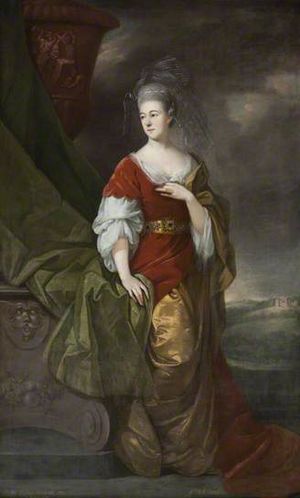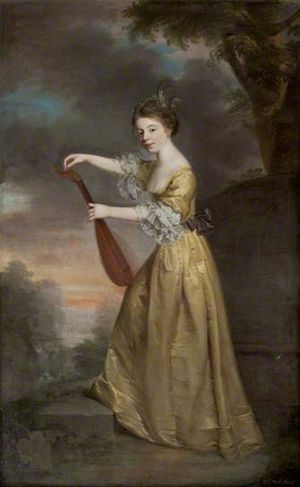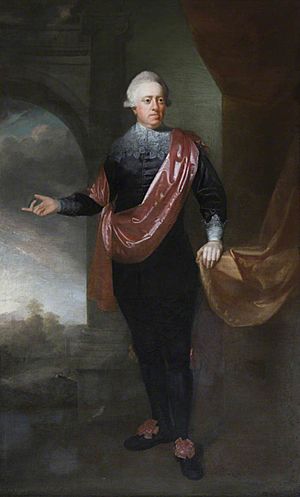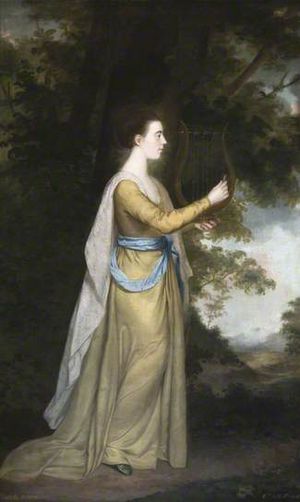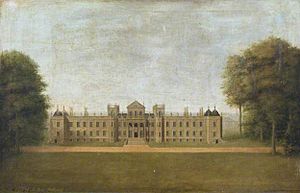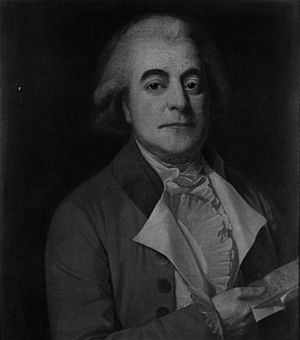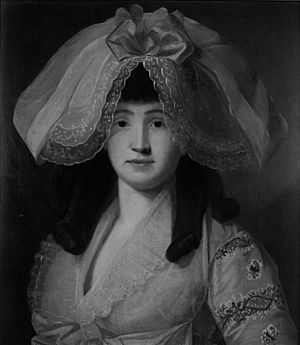William Bell (artist) facts for kids
Quick facts for kids
William Bell
|
|
|---|---|
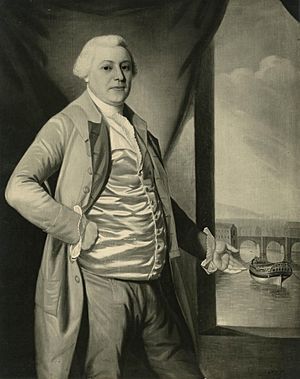
"Mr Bell" - probably a self-portrait
|
|
| Born | c1734 Newcastle upon Tyne, England
|
| Died | 8 June 1794 Newcastle upon Tyne, England
|
| Nationality | British |
William Bell (born around 1734 or 1735, died 1794) was an English artist. He was famous for painting portraits of people. William Bell was a very talented student at the Royal Academy of Arts in London. He learned a lot from famous painters like Sir Joshua Reynolds.
Bell became a well-known artist in his home area, the North East of England. Some of his most famous paintings are portraits of Sir John Delaval and his family. These paintings can be seen today at Seaton Delaval Hall in Northumberland, which is looked after by the National Trust. Another one of his paintings, a portrait of Robert Harrison, is kept at the National Portrait Gallery, London.
Contents
William Bell's Early Life
William Bell was born in Newcastle upon Tyne around 1734 or 1735. His father, also named William, was a respected bookbinder. William was the only son who lived to be an adult.
He grew up in Newcastle during an exciting time. The city's cultural and intellectual life was really growing. When he was a young man, he might have started as a house painter. But by the early 1760s, he was already known as an artist and was married.
Bell's Painting Career
William Bell's career got a big boost when the Royal Academy of Arts was started in 1768. On January 30, 1769, when he was 34, he became one of the first six students to join the Royal Academy Schools. These schools allowed young artists to learn from master painters in London.
In the same year, he entered the Academy's yearly art competition. He didn't win that time, but he tried again in 1771. This time, he won a gold medal! Sir Joshua Reynolds, the president of the Academy, presented the medal to him. The local newspaper, the Newcastle Courant, reported his success. It said he won "his Majesty's premium of a gold medal" for his historical painting. The painting was called Venus intreating Vulcan to forge the armour of Aeneas.
Once a student won a medal from the Royal Academy, they couldn't enter the same competition again. So, William Bell looked for other prizes. In 1772, he won 20 guineas (a type of money) for the "best historical painting" from the Society of Arts.
While he was studying in London, Bell also spent time back home. He painted for Sir John Delaval. His most important project was a series of family portraits. In 1770, he painted Lady Susanna Delaval (Sir John's wife) and their two oldest children. The next year, he painted their daughters Frances and Sarah together. Later, in 1774, he painted Sir John and his daughter Elizabeth. These were all life-size, full-length portraits. They were meant to be displayed in the entrance hall of Seaton Delaval Hall, the Delaval family's main home.
Bell also showed his paintings in London. In 1775, the Royal Academy displayed two of his pictures. They showed Seaton Delaval Hall from different sides. The next year, the Free Society of Artists showed his large historical painting, Susanna and the Two Elders. This was the last painting he made in London.
For the next 18 years, until he died, Bell lived and worked only in the North East of England. He focused on painting smaller, more personal portraits for people in his local area. He painted many important people, including Thomas Bewick, a famous engraver, and Joseph Austin, an actor. William Bell continued painting successfully into the 1790s. He died on June 8, 1794, at the age of 60, in the Newcastle Infirmary. He was buried two days later.
Working with the Delaval Family
A very important part of William Bell's life was the support he received from Sir John Delaval. Sir John was a successful businessman. His family owned several large country homes, like Seaton Delaval Hall, and also had a house in London. For many years, the Delaval family hired artists to paint portraits and teach their children art. William Bell became very close to the family.
Sir John Delaval enjoyed starting new projects. After he became a baronet in 1761, he wanted to show off his wealth. He did this by improving his properties. He added more family portraits to his home, hiring famous painters like Joshua Reynolds. Then, in the late 1760s, he focused on Seaton Delaval Hall. He hired William Bell to help him with his plans.
Sir John was so impressed with Bell's work that he offered him a yearly income of £50 (which would be about £9,000 today) and a cottage to live in. This meant Bell became Sir John's personal artist. He painted large pictures and taught drawing to the Delaval children. A great benefit for Bell was that when he was studying and painting in London, he could stay at the Delaval family's London home.
This support from Sir John, along with Bell's studies at the Royal Academy, meant he traveled a lot for several years. He stayed in London when needed but regularly returned to his cottage in Northumberland. At first, he lived right next to Seaton Delaval Hall. By 1777, he lived at Fountain Head, a small group of homes near the Hall. In this country setting, he and his wife Elizabeth had three children: Elizabeth (born 1773), Frances (born 1775), and Sarah Ann (born 1777).
Bell became well-known in the community and was seen as an important person, often called "Mr. Bell." He famously used local people as models for his award-winning painting in 1771. For example, Vulcan, the god who forges armor, was based on a local blacksmith named Willie Carr. Willie Carr was very tall and strong. Both Carr and Bell were good friends with Sir John Delaval and even had dinner with him.
Moving Back to Newcastle
Around 1775, William Bell's career changed. After finishing his studies at the Royal Academy, he hadn't become as famous in London as some of his friends. He hadn't shown many paintings at the Academy or become one of their special members. He could have become an assistant to Sir Joshua Reynolds, tried to work independently, or continued to rely on Sir John Delaval's support.
He chose to keep Sir John's support. However, things became a bit difficult because Sir John Delaval went through a tough time. In July 1775, Sir John's only son, Jack, died suddenly at age 19. This meant Sir John no longer had a son to inherit his estates. Also, a long family argument over property made Sir John angry with his brother in London. This made it less comfortable for Bell to stay at Sir John's London home. After 1776, Bell stopped trying to have a career in London.
Bell returned to his cottage in Northumberland. He continued to work for Sir John Delaval, though he didn't create many more major works for Seaton Delaval Hall. However, he did paint two pictures for the St. John Masonic Lodge in Newcastle, which opened in 1777. Since Sir John Delaval was an important freemason, he likely helped Bell get this job.
In late 1778, Bell helped prepare two pictures for William Hutchinson's book, A View of Northumberland. This book showed stately homes and included a description of "the seat of Sir John Delaval." It also had two pictures of the Hall, based on Bell's oil paintings from 1775.
For the next two years, Bell remained working at Seaton Delaval Hall. We don't know of any specific works he created during this time.
William Bell in Newcastle
Around 1781 or early 1782, Bell moved to Newcastle. This happened after his father died in 1780. He might have used money he inherited to start his own business as a portrait painter.
At this time, Thomas Bewick, the engraver, also set up his business in Newcastle. Bewick became good friends with Bell. Later, Bewick wrote that Bell was "accounted eminent in that profession" (meaning, famous as a painter). Knowing Bewick meant Bell was part of a large social group. This group included Joseph Bell (not related to William), who ran a painting and decorating business in Newcastle. When William Bell arrived in Newcastle, he chose to work at the same address as Joseph. He probably bought his paints from Joseph.
William Bell's studio was in a nice part of town, full of skilled workers and professionals. He worked from his studio on Newgate Street until at least 1793, and probably for the rest of his life. During this time, he developed his own style of less formal portraits. However, painting portraits didn't always make a lot of money. So, he found other ways to earn income.
First, he taught drawing. He did this at a different address in Newcastle, called the Back Row. However, local business guides listed him as a portrait painter and drawing teacher at the same Newgate Street address.
Second, he copied paintings. For example, in 1788, Lord Delaval asked him to make smaller copies of some family portraits Bell had painted years earlier for Seaton Delaval Hall. A letter mentions these copies. It's interesting that even though Bell was no longer on the Delaval family's regular payroll, Lord Delaval still gave him occasional work.
Third, Bell restored old paintings. This might not have been a regular job, but it's known that after a fire at Newcastle's Guildhall in 1791, he repaired portraits of King Charles II and James II.
By the end of his life, Bell was well-respected in his home area. The medal he won in 1771 became a famous trophy in Newcastle. A local historian named John Brand described it in detail in 1789. He said it weighed about four ounces. On one side was the head of King George III. On the other side was a picture of Minerva guiding a young person to the Temple of Fame.
Four days after Bell died in 1794, the Newcastle Courant newspaper published a tribute. It said he was "an eminent Portrait Painter, whose memory will be esteemed as long as his animated productions remain."
A generation later, another local historian, Eneas Mackenzie, wrote about Bell's final years in Newcastle. He said that Bell was "but indifferently supported, though his portraits were extremely accurate and beautifully finished." This means he didn't always have a lot of money, even though his paintings were very good.
William Bell's Known Works
Here is a list of paintings known to be by William Bell, in order from oldest to newest. An asterisk (*) means we don't know where the painting is now. Many of these paintings are mentioned above, and some are shown in the gallery below.
- Two Children and a Lamb* (around 1921)
- Time discovering Truth, with two other figures of Envy and Detraction* (1769)
- Lady Susanna Delaval (1730-1783) (1770) - At Seaton Delaval Hall.
- John Delaval (1756-1775) (1770) - At Seaton Delaval Hall.
- Sophia Delaval (1755-1793) (1770) - At Seaton Delaval Hall.
- Mr. Holmes* (around 1771)
- Mrs. Holmes* (around 1771)
- Venus Entreating Vulcan to Make Armour for Aeneas* (1771) - Won gold medal.
- Frances Delaval (1759-1839) and Sarah Delaval (1763-1800) (1771) - At Seaton Delaval Hall.
- Historical painting (subject unknown)* (1772) - Won 20 guineas.
- Two views of Seaton Delaval Hall (1773) - In the Duke of Northumberland's collection.
- Two views of Ford Castle (undated) - In the Duke of Northumberland's collection.
- Elizabeth Delaval (1757-1785) (1774) - At Seaton Delaval Hall.
- Sir John Hussey Delaval (1728-1808) (1774) - At Seaton Delaval Hall.
- Two views of Seaton Delaval Hall (1775) - At Seaton Delaval Hall.
- Susanna and the Two Elders* (1776)
- Francis Peacock, Masonic Grand Master* (1777)
- Saint John* (1777)
- Unnamed Gentleman* (undated)
- Unnamed Lady* (1782)
- John Langlands (1773-1804)* (1782)
- Mr. Bell* (1785) - Probably a self-portrait.
- Sir John Hussey Delaval (1728-1808) (1788?) - At Seaton Delaval Hall, a copy of his earlier work.
- John Delaval (1756-1775) (1788?) - At Seaton Delaval Hall, a copy of his earlier work.
- Sophia Jadis, nee Delaval (1752-1793)* (1788)
- Joseph Austin (c1740-1821)* (1788)
- Eleanor Austin (1757-1800), wife of Joseph* (around 1788)
- Thomas Bewick (1753-1828)* (undated)
- William Potter (1747-1839) (around 1790) - In a private collection.
- Robert Harrison (1715-1802) (1791) - At the National Portrait Gallery, London.
Gallery


